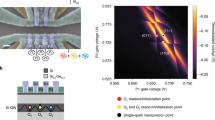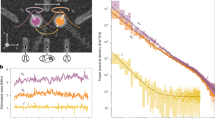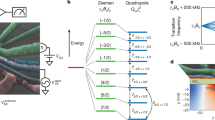Abstract
Entanglement is the quintessential quantum phenomenon. It is a necessary ingredient in most emerging quantum technologies, including quantum repeaters1, quantum information processing2 and the strongest forms of quantum cryptography3. Spin ensembles, such as those used in liquid-state nuclear magnetic resonance4,5, have been important for the development of quantum control methods. However, these demonstrations contain no entanglement and ultimately constitute classical simulations of quantum algorithms. Here we report the on-demand generation of entanglement between an ensemble of electron and nuclear spins in isotopically engineered, phosphorus-doped silicon. We combined high-field (3.4 T), low-temperature (2.9 K) electron spin resonance with hyperpolarization of the 31P nuclear spin to obtain an initial state of sufficient purity to create a non-classical, inseparable state. The state was verified using density matrix tomography based on geometric phase gates, and had a fidelity of 98% relative to the ideal state at this field and temperature. The entanglement operation was performed simultaneously, with high fidelity, on 1010 spin pairs; this fulfils one of the essential requirements for a silicon-based quantum information processor.
This is a preview of subscription content, access via your institution
Access options
Subscription info for Japanese customers
We have a dedicated website for our Japanese customers. Please go to natureasia.com to subscribe to this journal.
Buy this article
- Purchase on SpringerLink
- Instant access to full article PDF
Prices may be subject to local taxes which are calculated during checkout



Similar content being viewed by others
References
Briegel, H.-J., Dür, W., Cirac, J. I. & Zoller, P. Quantum repeaters: the role of imperfect local operations in quantum communication. Phys. Rev. Lett. 81, 5932–5935 (1998)
Jozsa, R. & Linden, N. On the role of entanglement in quantum-computational speed-up. Proc. R. Soc. Lond. A 459, 2011–2032 (2003)
Curty, M., Lewenstein, M. & Lütkenhaus, N. Entanglement as a precondition for secure quantum key distribution. Phys. Rev. Lett. 92, 217903 (2004)
Vandersypen, L. et al. Experimental realization of Shor’s quantum factoring algorithm using nuclear magnetic resonance. Nature 414, 883–887 (2001)
Negrevergne, C. et al. Benchmarking quantum control methods on a 12-qubit system. Phys. Rev. Lett. 96, 170501 (2006)
Knill, E., Chuang, I. & Laflamme, R. Effective pure states for bulk quantum computation. Phys. Rev. A 57, 3348–3363 (1998)
Horodecki, M., Horodecki, P. & Horodecki, R. Separability of mixed states: necessary and sufficient conditions. Phys. Lett. A 223, 1–8 (1996)
Peres, A. Separability criterion for density matrices. Phys. Rev. Lett. 77, 1413–1415 (1996)
Mehring, M., Mende, J. & Scherer, W. Entanglement between an electron and a nuclear spin 1/2. Phys. Rev. Lett. 90, 153001 (2003)
Anwar, M. et al. Preparing high purity initial states for nuclear magnetic resonance quantum computing. Phys. Rev. Lett. 93, 040501 (2004)
Morton, J. J. L. et al. Solid-state quantum memory using the 31P nuclear spin. Nature 455, 1085–1088 (2008)
Tyryshkin, A. M. & Lyon, S. A. Data presented at the Silicon Qubit Workshop, 23-24 August (Albuquerque, sponsored by Lawrence Berkeley National Laboratory and Sandia National Laboratory, 2010)
Tyryshkin, A. M. et al. Coherence of spin qubits in silicon. J. Phys. Condens. Matter 18, S783–S794 (2006)
Morton, J. J. L. et al. High fidelity single qubit operations using pulsed electron paramagnetic resonance. Phys. Rev. Lett. 95, 200501 (2005)
Kane, B. E. A silicon-based nuclear spin quantum computer. Nature 393, 133–137 (1998)
Wollan, D. S. Dynamic nuclear polarization with an inhomogeneously broadened ESR line. II. Experiment. Phys. Rev. B 13, 3686–3696 (1976)
Hayashi, H., Itahashi, T., Itoh, K. M., Vlasenko, L. S. & Vlasenko, M. P. Dynamic nuclear polarization of 29Si nuclei in isotopically controlled phosphorus doped silicon. Phys. Rev. B 80, 045201 (2009)
Schulman, L., Mor, T. & Weinstein, Y. Physical limits of heat-bath algorithmic cooling. Phys. Rev. Lett. 94, 120501 (2005)
Wei, T. et al. Maximal entanglement versus entropy for mixed quantum states. Phys. Rev. A 67, 022110 (2003)
Verstraete, F., Audenaert, K. & De Moor, B. Maximally entangled mixed states of two qubits. Phys. Rev. A 64, 012316 (2001)
Aharonov, Y. & Anandan, J. Phase change during a cyclic quantum evolution. Phys. Rev. Lett. 58, 1593–1596 (1987)
Suter, D., Mueller, K. T. & Pines, A. Study of the Aharonov-Anandan quantum phase by NMR interferometry. Phys. Rev. Lett. 60, 1218–1220 (1988)
Simmons, S., Jones, J. A., Karlen, S. D., Ardavan, A. & Morton, J. J. L. Magnetic field sensors using 13-spin cat states. Phys. Rev. A 82, 022330 (2010)
Campbell, E. T. Distributed quantum-information processing with minimal local resources. Phys. Rev. A 76, 040302 (2007)
Morton, J. J. L. A silicon-based cluster state quantum computer. Preprint at 〈http://128.84.158.119/abs/0905.4008v1〉 (2009)
Mehring, M. & Mende, J. Spin-bus concept of spin quantum computing. Phys. Rev. A 73, 052303 (2006)
Skinner, A., Davenport, M. & Kane, B. Hydrogenic spin quantum computing in silicon: a digital approach. Phys. Rev. Lett. 90, 087901 (2003)
Andresen, S. et al. Charge state control and relaxation in an atomically doped silicon device. Nano Lett. 7, 2000–2003 (2007)
Morello, A. et al. Single-shot readout of an electron spin in silicon. Nature 467, 687–691 (2010)
Becker, P., Pohl, H.-J., Riemann, H. & Abrosimov, N. Enrichment of silicon for a better kilogram. Phys. Status Solidi. A 207, 49–66 (2009)
Acknowledgements
We thank J. Fitzsimons, S. Benjamin, A. Ardavan, A. Briggs and B. Lovett for discussions, and P. Höfer and Bruker BioSpin for support with instrumentation. Three-dimensional images were created using POV-RAY open-source software. We thank EPSRC for supporting work at Oxford through CAESR (EP/D048559/1) and the Oxford–Keio collaboration through the JST-EPSRC SIC programme (EP/H025952/1). Work at Keio has been supported by Grants-in-aid for Scientific Research by MEXT, FIRST by JSPS, Nanoquine and Keio GCOE. S.S. is supported by the Clarendon Fund, J.J.L.M. is supported by St John’s College, Oxford, and the Royal Society.
Author information
Authors and Affiliations
Contributions
S.S., R.M.B. and J.J.L.M. designed and performed the experiments and wrote the paper. H.R., N.V.A., P.B. and H.-J.P. grew the 28Si crystal. K.M.I and M.L.W.T. analysed and prepared the sample and discussed the experiments, results and manuscript.
Corresponding author
Ethics declarations
Competing interests
The authors declare no competing financial interests.
Supplementary information
Supplementary Information
This file contains Supplementary Information and Data, Supplementary Figure 1 and legend and additional references. (PDF 262 kb)
Rights and permissions
About this article
Cite this article
Simmons, S., Brown, R., Riemann, H. et al. Entanglement in a solid-state spin ensemble. Nature 470, 69–72 (2011). https://doi.org/10.1038/nature09696
Received:
Accepted:
Published:
Issue Date:
DOI: https://doi.org/10.1038/nature09696
This article is cited by
-
Wigner-molecularization-enabled dynamic nuclear polarization
Nature Communications (2023)
-
Experimental realisation of multi-qubit gates using electron paramagnetic resonance
Nature Communications (2023)
-
Towards entanglement distillation between atomic ensembles using high-fidelity spin operations
Communications Physics (2022)
-
Universal control of a six-qubit quantum processor in silicon
Nature (2022)
-
Quantum guidelines for solid-state spin defects
Nature Reviews Materials (2021)



